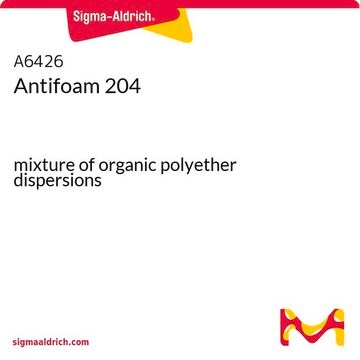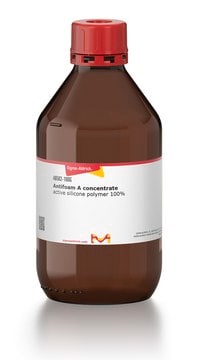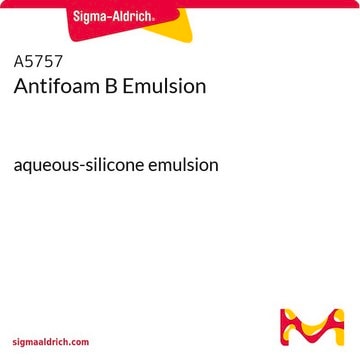추천 제품
Quality Level
형태
emulsion (aqueous)
농도
100% (organic)
density
1.01 g/mL at 25 °C
응용 분야
microbiology
저장 온도
room temp
적합성
(Mammalian (suspension))
bacteria (fermentation)
유사한 제품을 찾으십니까? 방문 제품 비교 안내
일반 설명
Antifoam 204 is an organic antifoam used to prevent or minimize foaming in both microbial fermentation systems and mammalian suspension cultures. Control of foaming minimizes damage to the cells, resulting in increased protein/antibody production.
애플리케이션
Suitable for preventing or minimizing foaming in microbial fermentation systems and mammalian suspension cultures.
Antifoam 204 has been used:
Antifoam 204 has been used:
- in the expression and purification of PUL (PLAP, Ufd3p, and Lub1p) domain
- in fed-batch fermentation
- to prevent bubble formation due in aeration in Luria Bertani (LB) culture medium for bacterial growth
- in the batch fermentation with mineral medium
성분
Antifoam 204 is a 100% active components and a mixture of non-silicone organic defoamers in a polyol dispersion.
기타 정보
Contains 100% active components and is a mixture of non-silicone organic defoamers in a polyol dispersion. Can be sterilized repeatedly.
제조 메모
For use in microbiological media Sigma recommends a starting concentration of between 0.005% and 0.01%.
The optimal amount of antifoam required for various applications will need to be determined. Antifoam 204 is soluble in methanol, ethanol, toluene, xylene, perchloroethylene, and cold water at temperatures below 15 °C. It is insoluble in warm water and ethylene glycol.
The optimal amount of antifoam required for various applications will need to be determined. Antifoam 204 is soluble in methanol, ethanol, toluene, xylene, perchloroethylene, and cold water at temperatures below 15 °C. It is insoluble in warm water and ethylene glycol.
Storage Class Code
10 - Combustible liquids
WGK
WGK 3
Flash Point (°F)
Not applicable
Flash Point (°C)
Not applicable
개인 보호 장비
Eyeshields, Gloves
시험 성적서(COA)
제품의 로트/배치 번호를 입력하여 시험 성적서(COA)을 검색하십시오. 로트 및 배치 번호는 제품 라벨에 있는 ‘로트’ 또는 ‘배치’라는 용어 뒤에서 찾을 수 있습니다.
이미 열람한 고객
Yixin Yang et al.
Biomacromolecules, 11(1), 259-268 (2009-12-17)
Biobased omega-carboxy fatty acid monomers 1,18-cis-9-octadecenedioic, 1,22-cis-9-docosenedioic, and 1,18-cis-9,10-epoxy-octadecanedioic acids were synthesized in high conversion yields from oleic, erucic and epoxy stearic acids by whole-cell biotransformations catalyzed by C. tropicalis ATCC20962. Maximum volumetric yields in shake-flasks were 17.3, 14.2, and
Beth Junker
Biotechnology progress, 23(4), 767-784 (2007-06-15)
Key aspects of foaming and its mitigation in fermentation systems are presented. Foam properties and behavior, conditions that affect foaming, and consequences of foaming are discussed, followed by methods to detect and prevent foam, both without and with the use
Comparison of the metabolic response to over-production of p-coumaric acid in two yeast strains
Rodriguez A, et al.
Metabolic engineering, 44, 265-272 (2017)
Bouke Wim de Jong et al.
FEMS yeast research, 16(1), fov105-fov105 (2015-11-23)
Saccharomyces cerevisiae has previously been engineered to become a cell factory for the production of fatty acid ethyl esters (FAEEs), molecules suitable for crude diesel replacement. To find new metabolic engineering targets for the improvement of FAEE cell factories, three
Enhancing algal biomass and lipid production by phycospheric bacterial volatiles and possible growth enhancing factor
Cho K, et al.
Algal research, 37, 186-194 (2019)
자사의 과학자팀은 생명 과학, 재료 과학, 화학 합성, 크로마토그래피, 분석 및 기타 많은 영역을 포함한 모든 과학 분야에 경험이 있습니다..
고객지원팀으로 연락바랍니다.










